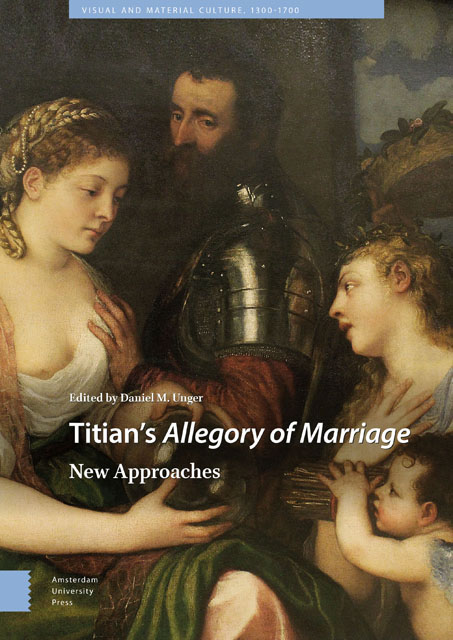Book contents
- Frontmatter
- Table of Contents
- List of Plates and Figures
- 1 Introduction: Poetic License
- 2 Love, Beauty, and the Human Body as a Reflection of the Divine
- 3 Amorosa visione: Titian’s Allegory of Marriage and the Poetry of the Half-length Format
- 4 The Arms and Armour of Titian’s Allegory of Marriage
- 5 ‘Un disio sol d’eterna gloria e fama’: A Literary Approach to Titian’s Allegory
- 6 Psyche, Venus, Ceres and Their Friends: Titian’s Remixes
- 7 Art and the Double Meaning of Reflection in Titian’s Allegory of Marriage
- 8 Titian’s Allegory of Marriage as an ‘Allegory of Peace’
- 9 Vision and Touch in the Allegory of Marriage
- 10 Of Crystal Orbs and Divinatory Mirrors : The Vicissitudes of Pregnancy and Artistic Agency in Titian’s Allegory of Marriage
- Index
8 - Titian’s Allegory of Marriage as an ‘Allegory of Peace’
Published online by Cambridge University Press: 16 November 2022
- Frontmatter
- Table of Contents
- List of Plates and Figures
- 1 Introduction: Poetic License
- 2 Love, Beauty, and the Human Body as a Reflection of the Divine
- 3 Amorosa visione: Titian’s Allegory of Marriage and the Poetry of the Half-length Format
- 4 The Arms and Armour of Titian’s Allegory of Marriage
- 5 ‘Un disio sol d’eterna gloria e fama’: A Literary Approach to Titian’s Allegory
- 6 Psyche, Venus, Ceres and Their Friends: Titian’s Remixes
- 7 Art and the Double Meaning of Reflection in Titian’s Allegory of Marriage
- 8 Titian’s Allegory of Marriage as an ‘Allegory of Peace’
- 9 Vision and Touch in the Allegory of Marriage
- 10 Of Crystal Orbs and Divinatory Mirrors : The Vicissitudes of Pregnancy and Artistic Agency in Titian’s Allegory of Marriage
- Index
Summary
Abstract
This chapter interprets Titian's painting as an allegory of peace, integrating the mythological account of Mars and Venus with a political symbol of balance, as represented by the sphere held by the female protagonist. The mythological story of the love affair of Mars and Venus as told by Lucretius, Statius, and Plutarch, and the visual representations that followed this tradition are discussed as the sources for Titian's painting. Contrary to previous readings of the glass sphere as a symbol of transience or inconsistency, it is discussed here as a sign of balance in relation to an iconographical precedent. This new reading of Titian's Allegory is strengthened by the consideration of its influence on successive allegorical paintings of peace.
Key Words: Allegory of peace, Titian, Rubens, Venus and Mars, Montefeltro, sphere
The identities of the male and female protagonists in the Allegory of Marriage (Plate 1) have been much discussed and debated. In his famous interpretation of the painting, Erwin Panofsky ruled out the identification of the man in armour as the Marquis d’Avalos. According to Panofsky, the man and woman in Titian's painting are no other than the mythological figures of Mars and Venus, as construed in a late antique tradition in medieval mythography, in which their union produced a daughter named Harmonia (harmony). Such mythological depictions were often used as models for double portraits, so although we do not know the subject of the portrayal, Panofsky assumed that the painting is also a portrait in mythological disguise. He grounded his interpretation on two kinds of texts: The Neoplatonic reading of the union of Venus and Mars and the astrological reading of the Venus-Mars myth. According to latter, the coming of the month of April (signified by Venus) after the month of March (signified by Mars) is a sign of Venus's mollifying force over the ferocious Mars, as expressed in the accounts of Lucretius's De rerum natura, and Statius's Thebaid, to which I return shortly.
In identifying the protagonists as Venus and Mars, Panofsky set the tone for future investigation and interpretation of the painting, although two components remained enigmatic— the male figure's gesture and the glass sphere.
- Type
- Chapter
- Information
- Titian's Allegory of MarriageNew Approaches, pp. 183 - 200Publisher: Amsterdam University PressPrint publication year: 2022

